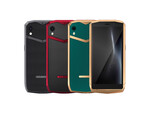Cubot Pocket
Ausstattung / Datenblatt

Secondary Camera: 5 MPix
Preisvergleich
Durchschnitt von 2 Bewertungen (aus 3 Tests)
Testberichte für das Cubot Pocket
Gerade mal 4 Zoll misst der Bildschirm des Cubot Pocket. Damit ist es ideal für kleine Hände und schmale Taschen. Ganz so günstig wie früher sind die ultrahandlichen Android-Handys von Cubot nicht mehr, lohnt sich das Pocket dennoch?
Quelle: Chinahandys.net

Als Galaxy S5 mini Nachfolger kann man das Cubot Pocket jedoch leider nicht bezeichnen. Das letzte Mini von Samsung kam immerhin mit 4,5 Zoll Super-AMOLED Display und Samsungs Exynos 3470, einem Mittelklasse-SoC daher.
Einzeltest, online verfügbar, Lang, Datum: 08.07.2022
Bewertung: Gesamt: 68% Leistung: 70% Bildschirm: 60% Mobilität: 80% Gehäuse: 70%
Ausländische Testberichte
Quelle: Igeekphone
 EN→DE
EN→DEOverall, the Cubot Pocket is a very interesting concept. The phone is held well in hand and quickly forgotten in a pocket at the sight of its size. We couldn’t find anything wrong with the finish and the charger supplied as well as the protective shell is still a little extra today in view of the competition; especially in this price range. Cubot Pocket is a classic compact smartphone, the capabilities of which will be enough for most buyers. It’s fast, has good battery life, and offers contactless payment via NFC. The case made of durable plastic can save you from falls; and the choice of colors will definitely not leave you indifferent.
Einzeltest, online verfügbar, Sehr Lang, Datum: 28.12.2022
Quelle: Tech X Reviews
 EN→DE
EN→DEIn general, the Cubot Pocket is a smartphone for a certain segment of people. The phone is well held in the hand and is quickly forgotten in the pocket when seeing its size. We couldn’t find anything wrong with the finish, especially in this price range. Navigation on this mobile is seamless, as is the navigation between apps. However, this smartphone will not be suitable for heavy operations or 3D games … and it is not suitable for this screen size. The Android 11 version installed by default on the phone also works fine, but it starts to show a certain age in terms of graphic style and some very rare display errors can be encountered.
Einzeltest, online verfügbar, Mittel, Datum: 02.08.2022
Kommentar
Imagination PowerVR GE8300: Integrierter Grafikchip für ARM-Prozessoren der unteren Mittelklasse.
3D Spiele sind auf diesen Vertretern nur in Ausnahmen spielbar, grundsätzlich sind die Grafiklösungen hierfür jedoch nicht geeignet. Office Programme und Internet surfen dürfte jedoch ohne Problem möglich sein.
» Weitere Informationen gibt es in unserem Notebook-Grafikkartenvergleich und der Benchmarkliste.
T310: Einstiegsprozessor mit 4 Kernen in zwei Cluster. Ein großer ARM Cortex-A75-Kern mit bis zu 2 GHz und drei kleine Cortex-A55-Kerne mit bis zu 1,8 GHz.» Weitere Infos gibt es in unserem Prozessorvergleich Vergleich mobiler Prozessoren und der Prozessoren Benchmarkliste .

